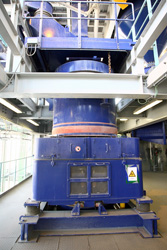Difference between revisions of "Rhodax Crushers"
(Created page with "Category:Particle Size Reduction{{Knoppen}} <noinclude><!------------------------------------------------ * READ THIS FIRST * Only edit this page if you can improve the ...") |
|||
| (3 intermediate revisions by 2 users not shown) | |||
| Line 7: | Line 7: | ||
* Please start editing this page after the /noinclude | * Please start editing this page after the /noinclude | ||
* -------------------------------------------------></noinclude> | * -------------------------------------------------></noinclude> | ||
[[File:Rhodax_Crusher.JPG|thumb|right|Rhodax Crusher outside look]] | |||
A '''Rhodax Crusher''' is a specialised form of a cone crusher, referred to as an inertial cone crusher. Developed by the FCB Research Centre in France, the Rhodax crusher is claimed to offer process advantages over conventional cone crushers and is based on inter-particle compression crushing. | |||
The Rhodax is an inertial cone grinder which means that the grinding parts are moved by rotating unbalanced masses, and not due to an eccentric mass as is the case for a conventional cone crusher. A horizontal circular oscillation movement, is caused by the rotation of two sets of unbalanced masses. These two sets of masses are synchronized with each other and subject the ring to a known and controlled mechanical force. This force creates a fragmentation force. | |||
Latest revision as of 22:19, 2 September 2012
A Rhodax Crusher is a specialised form of a cone crusher, referred to as an inertial cone crusher. Developed by the FCB Research Centre in France, the Rhodax crusher is claimed to offer process advantages over conventional cone crushers and is based on inter-particle compression crushing.
The Rhodax is an inertial cone grinder which means that the grinding parts are moved by rotating unbalanced masses, and not due to an eccentric mass as is the case for a conventional cone crusher. A horizontal circular oscillation movement, is caused by the rotation of two sets of unbalanced masses. These two sets of masses are synchronized with each other and subject the ring to a known and controlled mechanical force. This force creates a fragmentation force.
